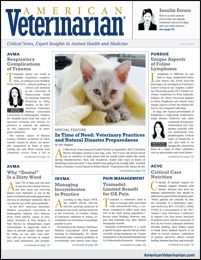Clinical Tidbits (May 2018)
Advice and insight from veterinary experts throughout the country.

“Several herbs can cause deleterious effects,” says Narda G. Robinson, DO, DVM, MS, FAAMA, president and CEO of CuraCore Integrative Medicine and Education Centers. Some herbs within the Chinese medical system can be toxic, including herbal strychnine, which can harm the nervous system, and aconite, which is neurotoxic and cardiotoxic. Some herbs dissolve tissue when applied topically, and others, such as comfrey and chaparral, could be toxic to the liver when ingested. “Something that is normal for a person to use, such as tea tree oil, could be lethal for a small dog or cat even when applied topically, depending on the amount and its concentration,” Dr. Robinson adds.
Her advice: “When asking about medications during a patient history, also inquire about any herbs the pet is taking,” she says. “It’s equally important, however, for veterinarians to understand the pharmacologic—and potentially toxic—effects of those herbs and not to rely on folklore and mysticism.”
Seizures: When Long-term Medications Are Needed
There are several indications for starting a long-term medication when a seizure is diagnosed, says Andrew Linklater, DVM, DACVECC, clinical instructor at Lakeshore Veterinary Specialists in Wisconsin. “If a patient presents in status epilepticus, is having cluster seizures, or experiences several seizures over a 3- to 4-month period,” he says, “those are indications that we should start the patient on medication so we can control the seizures and prevent the seizure disorder from affecting the patient more frequently later in life.” With few exceptions, he says, when a long-term oral antiepileptic drug is prescribed, the animal will need to remain on the medication for the rest of its life, although the dose and even the medication itself may be changed over time.

Gregg M. Griffenhagen, DVM, MS, DACVAA, anesthesiologist and clinical instructor at Colorado State University, says the biggest misconception he hears from other veterinarians about multimodal anesthesia is that they must use it all the time. “Multimodal anesthesia or analgesia just refers to minimizing side effects by combining multiple drugs with different sets of pharmacologic actions,” Dr. Griffenhagen says.
“People think they have to use 7 different drugs with 7 different modes of action to accomplish a single goal.” While he acknowledges that there are certainly patients for which you may need to do this, “it’s not always necessary. Sometimes a single drug will do just fine to accomplish exactly what you need it to do,” he says.
Incorporating Pheromones to Relieve Anxiety
Julie Reck, DVM, founder and owner of the Veterinary Medical Center of Fort Mill, South Carolina, says she can’t go a day in practice anymore without using pheromones. “But what’s really beneficial,” she says, “is to layer the pheromones by diffusing them in the air and placing them directly in contact with patients.
For dogs, her practice uses inexpensive seasonal fabrics and cuts out bandanas in 3 sizes. Then, they spray the bandanas with Adaptil and place them on patients. For cats, a Feliway-sprayed towel with catnip is applied directly to the front of the carrier. “Before we started doing this, we had about 20% of cats willingly come out of their carriers,” she notes. “Now it’s 75% to 80%, and it’s amazing how much better the exam goes when they volunteer to come out.”

H. Edward Durham Jr, CVT, RVT, LATG, VTS (Cardiology), senior anesthesia technician at Ross University School of Veterinary Medicine, says too often veterinary professionals fail to ask about clinical signs the patient displays at night. “Many people forget that orthopnea often presents as the inability to become comfortable and sleep at night,” he says. “Clients will often report that their dog is pacing at night or lying down and getting up repeatedly, and that’s actually a form of orthopnea.” In failing to ask about nighttime habits, a veterinarian might miss subtle signs that a patient might be in or on the verge of heart failure.
The Role of Staff in Radiography
“Performing proper orthopedic examinations and getting a diagnosis efficiently hinges a lot on your support staff,” says W. Preston Stubbs, DVM, DACVS, staff surgeon and owner of Mile High Veterinary Surgical Specialists. Empowering them to take a good patient history and follow up on that history is very important. “Your team also needs to be trained to assist in orthopedic examinations, understand proper restraint techniques, and know how to obtain high-quality, well-positioned radiographs,” he says.
Cannabis in Veterinary Medicine: Watch Your Words
Part of the problem with discussing cannabis-based products in the veterinary community is the misunderstanding that stems from using improper terminology, according to Stephen Cital, RVT, SRA, RLAT, VTS-Lab Animal, who serves on the board of Phyto Animal Health. “We have to be careful with the term medical marijuana,” he says. “Marijuana is a "breed" of plant we use that has a large THC component that has the potential for some pretty negative side effects that we want to avoid in our companion animals.” Instead of marijuana, he advises, veterinary professionals should be using the term hemp, which is a plant that has a higher concentration of other cannabinoids such as cannabidiol.
Some of the basis for using cannabis in veterinary medicine stems from research in human medicine, Cital says. More than 10,000 studies have been published using cannabis products for varying ailments in people, but the veterinary field is now conducting research on companion animals, as well, with studies under way at Colorado State University and Cornell University, among others. “Veterinarians are demanding research,” he says.
